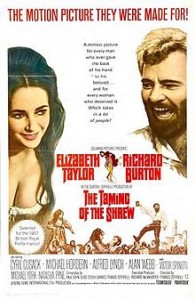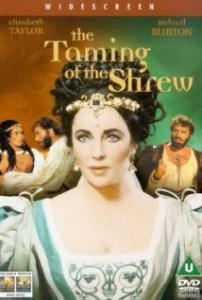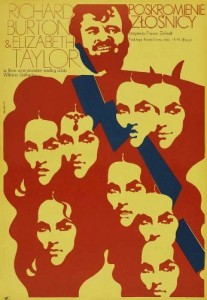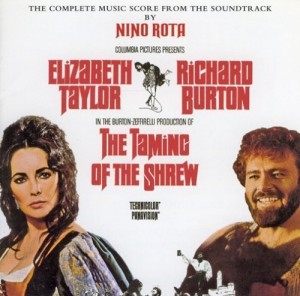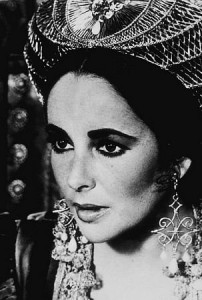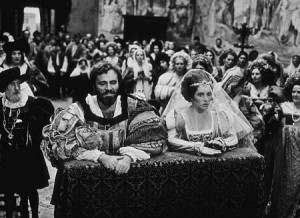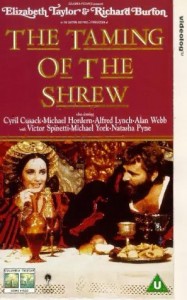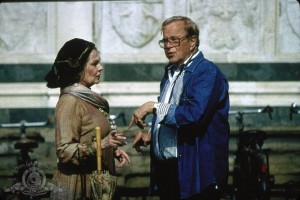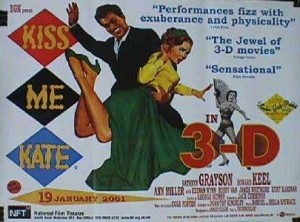The Taming of the Shrew **** (1967, Richard Burton, Elizabeth Taylor, Michael York, Michael Hordern, Cyril Cusack, Alfred Lynch) – Classic Movie Review 1118
Director Franco Zeffirelli brings immense zest, impressive vitality and glorious colour to his 1967 film of the William Shakespeare play The Taming of the Shrew, while ideally cast and on-form, fired-up Richard Burton and Elizabeth Taylor bring their star allure, enormous acting skills, great enthusiasm and huge charisma to the main roles as warring couple Petruchio and Katherine (Kate).
Shakespeare’s lively plot follows the stormy courtship between two exceptionally strong-willed people. Petruchio is a fortune-hunting scoundrel from Verona who arrives in Padua hoping to snare a wealthy wife. Hortensio directs Petruchio’s attention to Katherine, warning him about her sharp tongue and fiery temper, but this just makes Petruchio resolve to win her heart.
The happy result is a compelling, vivacious and delightful Italian-style version of Shakespeare’s great comedy, which seeks only to entertain through its emphasis more on amiable, light-hearted and good-natured comedy rather than any of the poetry or passion.
At heart it is so entertaining because the stars seem to be enjoying themselves in what plays like a comedic sequel to their devastating epic marital battle in Who’s Afraid of Virginia Woolf? Coming out best, the fiery Taylor deserves most praise, especially given her inexperience in Shakespeare and that she is acting opposite her classically theatre-trained husband. Playing alongside Burton obviously raised Taylor’s acting game and they show here why they were a great on-screen couple.
Michael York as Lucentio, Michael Hordern as Kate’s father Baptista, Cyril Cusack as Grumio, Alfred Lynch as Tranio, Natasha Pyne as Bianca, Alan Webb as Gremio, Victor Spinetti as Hortensio and Vernon Dobtcheff as Pedant are the best of a fine cast of supporting players to the stars.
Oswald Morris’s luscious cinematography, Nino Rota’s gorgeous score, the luxurious production designs and Danilo Donati’s delightful costumes are the outstanding contributions behind the camera. There were two well-deserved Academy Award nominations, for Best Costume Design (Danilo Donati) and Best Art Direction (Lorenzo Mongiardino, John DeCuir, Elven Webb, Giuseppe Mariani, Dario Simoni, Luigi Gervasi).
Zeffirelli’s film at least has the good grace to mention old Will. After the names of the screenwriters are listed, the credits read: ‘With acknowledgements to William Shakespeare without whom they would have been at a loss for words’.
Incidentally, replacing the traditional ‘The End’, ‘God give you goodnight’ appears before the closing credits.
Good reviews and the star power helped The Taming of the Shrew to gross a comfortably profitable $12 million worldwide.
In Italian, it is known as La Bisbetica domata. The film, made in English but shot in Italy, cuts much of the original dialogue, including much of the subplot of Lucentio and Bianca, and all of the Christopher Sly framing device. It was originally planned to star Sophia Loren and Marcello Mastroianni, but Taylor and Burton put more than $1 million into the production and took a percentage of profits instead of salaries.
Zeffirelli went on to film Romeo and Juliet (1968) the next year. The Taming of the Shrew and Romeo and Juliet remain the best-known film adaptation of those plays.
Oswald Morris, the acclaimed British cinematographer who earned an Oscar for the 1971 musical Fiddler on the Roof, died on 17 March 2014, aged 98. His last film was The Dark Crystal in 1982.
In April 2014, the 91-year-old Zeffirelli invited journalists to his villa on the outskirts of Rome to present a new coffee table book, Francesco, based on stunning photos from his 1972 Brother Sun, Sister Moon [Fratello sole, sorella luna], dramatising the life of St Francis.
Franco Zeffirelli died at his home in Rome on 15 June 2019, at the age of 96.
Kiss Me Kate (1953) is the Cole Porter musical version of The Taming of the Shrew.
Douglas Fairbanks Sr and his wife Mary Pickford star in director Sam Taylor’s 1929 The Taming of the Shrew.
© Derek Winnert 2014 Classic Movie Review 1118 derekwinnert.com

